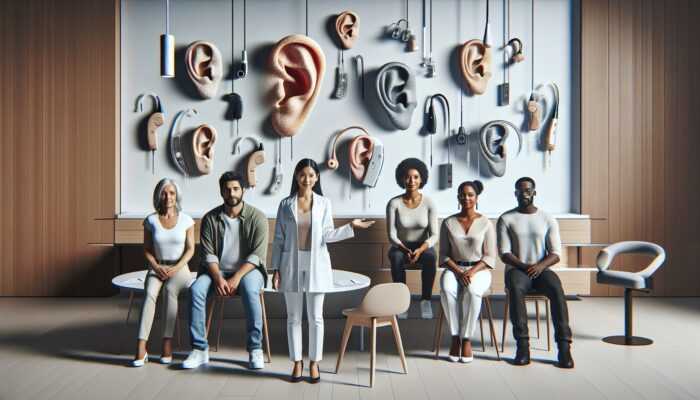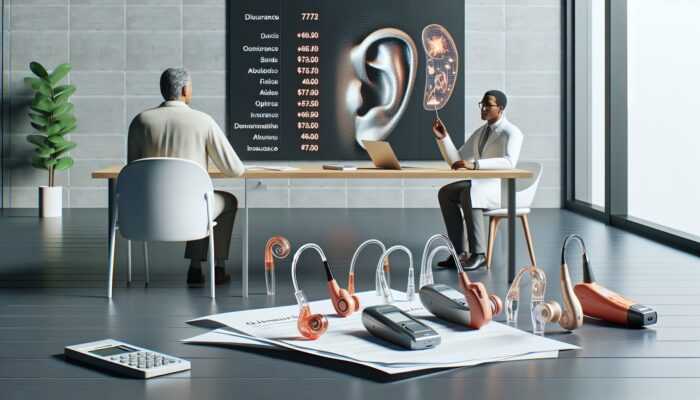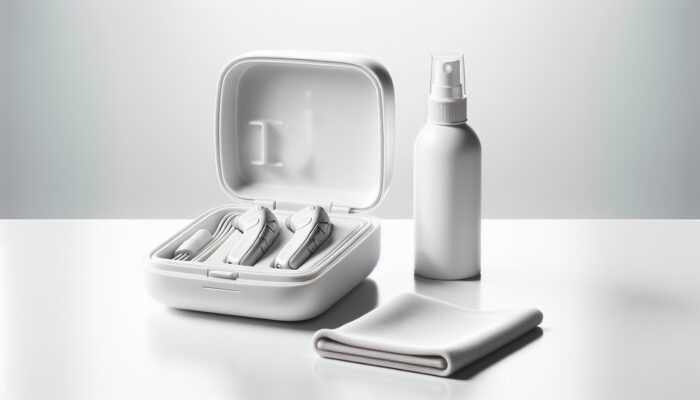Understanding the Essential Aspects of Hearing Loss
What Factors Are Responsible for Hearing Loss?

Hearing loss is a complex issue stemming from a myriad of factors that reflect the intricate nature of human biology and its interaction with environmental influences. Genetics significantly impacts this condition, as hereditary factors can predispose individuals to various types of hearing impairments. Additionally, aging plays a crucial role, with the natural decline of the auditory system often leading to diminished hearing capabilities as one grows older. Moreover, exposure to loud noises, whether from occupational settings or environmental conditions, has the potential to cause irreversible damage to the delicate structures responsible for hearing. Certain medical conditions, such as recurrent ear infections or otosclerosis, further complicate the landscape of hearing loss. Below is a comprehensive list of common contributors to this condition:
- Genetics
- Aging
- Exposure to loud noises
- Chronic ear infections
- Otosclerosis
- Certain medications (ototoxic drugs)
- Head injuries
- Neurological disorders
Recognising these causes is paramount for early detection and intervention. By understanding the underlying factors contributing to hearing loss, individuals can undertake informed lifestyle modifications and seek medical advice promptly, potentially preventing further deterioration of their hearing abilities.
What Are the Various Types of Hearing Loss?
Hearing loss is predominantly classified into three main types: conductive, sensorineural, and mixed. Each category possesses distinct characteristics that can significantly influence treatment approaches. Conductive hearing loss occurs when sound cannot reach the inner ear due to obstructions, which might be caused by earwax buildup, fluid in the middle ear, or structural abnormalities. This type of hearing loss is often manageable with medical or surgical interventions. Conversely, sensorineural hearing loss results from damage to the inner ear or auditory nerve, typically associated with aging or exposure to loud noises. This type is more challenging to treat, often necessitating hearing aids or cochlear implants. Mixed hearing loss combines elements of both conductive and sensorineural hearing loss, requiring a tailored treatment strategy.
Comprehending the different types of hearing loss is essential for recognising symptoms and seeking appropriate care, ultimately fostering improved hearing health and enhancing quality of life.
What Are the Initial Signs of Hearing Loss?
Identifying early indicators of hearing loss is crucial for timely intervention. Common symptoms include difficulty in comprehending speech, frequently asking others to repeat themselves, and the need to raise the volume on electronic devices. Individuals may perceive sounds as muffled or struggle to keep pace with conversations, particularly in noisy environments. Early detection can dramatically improve outcomes, as it enables individuals to pursue audiological evaluations and develop an effective management plan.
Taking proactive steps, such as scheduling regular hearing screenings and closely monitoring changes in auditory perception, can facilitate early intervention. By recognising these early signs, individuals can regain the joy of clear communication and maintain their social connections.
The Evolution of Hearing Loss Over Time

What Are the Different Stages of Hearing Loss?
Hearing loss typically progresses through several defined stages: mild, moderate, severe, and profound. Each stage presents unique challenges and characteristics. During the mild stage, individuals may struggle to hear soft sounds, rendering whispers or quiet conversations particularly challenging. As hearing loss advances to the moderate stage, comprehending speech becomes more difficult without the assistance of hearing aids. In the severe stage, significant barriers to following conversations arise, often necessitating technological aids to communicate effectively. Ultimately, in the profound stage, individuals may need to rely on visual cues, lip-reading, or sign language, as traditional auditory perception declines substantially.
Understanding these stages is vital for implementing effective management strategies. Early intervention at any stage can slow progression and enhance the quality of life for individuals experiencing hearing loss.
How Does Hearing Loss Influence Everyday Life?
As hearing loss develops, it profoundly impacts various facets of daily living. Communication difficulties can lead to feelings of frustration and social withdrawal. As engaging in conversations becomes increasingly arduous, social interactions may diminish, resulting in feelings of isolation. Furthermore, the cumulative effects of hearing loss can extend into professional settings, where misunderstandings can adversely affect workplace performance and relationships.
To navigate these challenges, strategies such as employing assistive listening devices, integrating visual aids into communication, and fostering supportive social environments can prove beneficial. Surrounding oneself with understanding individuals can enhance engagement and emotional well-being. By adopting proactive strategies, individuals can preserve their social connections and maintain their overall quality of life, even in the face of hearing challenges.
What Factors Affect the Progression of Hearing Loss?

Various factors can significantly influence the rate at which hearing loss progresses. Lifestyle choices, such as frequent exposure to loud environments, smoking, and unhealthy dietary habits, can accelerate auditory decline. Additionally, environmental influences, such as pollution and workplace hazards, contribute to the progression of hearing loss. Health conditions, including diabetes and hypertension, can exacerbate hearing loss and complicate management efforts.
Mitigating these factors requires adopting healthier lifestyle habits, such as minimising exposure to loud noises, maintaining a balanced diet rich in vitamins that support ear health, and effectively managing chronic health conditions. Regular medical check-ups can help identify potential issues early, allowing for a more informed approach to hearing health and prevention.
Why Is It Crucial to Monitor and Manage Hearing Loss Progression?
To effectively address the progression of hearing loss, consistent monitoring is essential. Regular visits to an audiologist for check-ups can help track changes in hearing ability and enable timely intervention. Moreover, utilising appropriate hearing aids or assistive devices can significantly enhance auditory perception, allowing individuals to maintain their quality of life.
Monitoring strategies may include keeping a record of hearing abilities, noting any changes in communication challenges, and seeking professional advice when necessary. Engaging with support groups or networks can also provide encouragement and share successful management techniques. By prioritising monitoring, individuals can take control of their hearing health and navigate the challenges associated with hearing loss more effectively.
Expert Insights on the Progression of Hearing Loss Over Time
What Recommendations Do Audiologists Offer?
Audiologists are essential professionals in the understanding and management of hearing loss. They advocate for a comprehensive approach to hearing health that encompasses regular assessments and personalised interventions. For example, individuals diagnosed with mild hearing loss may benefit from custom hearing aids that amplify specific frequencies without overwhelming the user with excessive sound. Real-world examples illustrate the effectiveness of early intervention; patients who adopt hearing aids at the onset of mild hearing loss often report improvements in communication and social engagement, thereby alleviating feelings of isolation.
Audiologists also emphasise the importance of patient education. Gaining a thorough understanding of one’s condition empowers individuals to make informed choices regarding their hearing health, leading to improved outcomes. The collaborative relationship between audiologists and patients forms a vital support system, fostering proactive management of hearing health.
What Does Current Research Indicate About Hearing Loss Progression?
Cutting-edge research continues to unveil the complexities surrounding the progression of hearing loss. Recent studies have explored the connection between hearing loss and cognitive decline, indicating that untreated hearing impairment may accelerate cognitive deterioration. This association underscores the critical importance of early intervention and ongoing management of hearing health.
Expert analysis of these findings suggests that addressing hearing loss not only enhances auditory experiences but may also yield cognitive benefits. Engaging with auditory stimuli through hearing aids or similar devices can stimulate brain activity, potentially slowing cognitive decline. As our understanding of hearing loss evolves, so too do the strategies for effective management, highlighting the need for a multidimensional approach to hearing health.
What Preventive Measures Do Experts Recommend?
Experts advocate for a variety of preventive measures aimed at slowing the progression of hearing loss. These strategies encompass lifestyle modifications and proactive health management. Individuals can adopt simple yet effective practices, including:
- Minimising exposure to loud noises by using ear protection
- Engaging in regular hearing screenings
- Maintaining a balanced diet rich in antioxidants and omega-3 fatty acids
- Exercising regularly to promote cardiovascular health
- Avoiding ototoxic medications when possible
- Effectively managing chronic health conditions
- Staying socially active to engage auditory and cognitive faculties
- Educating oneself about hearing health and available technologies
By implementing these measures, individuals can take a proactive stance in managing their hearing health, ultimately enhancing their quality of life and reducing the risk associated with hearing loss.
The Relationship Between Hearing Loss and Mental Health
How Does Hearing Loss Affect Mental Well-being?
Hearing loss can have profound implications for mental health, often leading to social isolation, <a href="https://www.earwaxremoval.net/hearing-health-a-crucial-issue-for-farmers-everywhere/">depression</a>, and anxiety. The communication challenges associated with hearing impairment can foster feelings of frustration and inadequacy, further exacerbating emotional distress. As individuals withdraw from social interactions due to these difficulties, their sense of isolation can deepen, creating a cycle that compromises overall well-being.
Addressing the psychological impacts of hearing loss is essential for holistic health management. Individuals experiencing hearing loss should be encouraged to seek support, participate in social activities, and openly communicate their feelings. Establishing connections with others facing similar challenges can be immensely beneficial, fostering a sense of community and belonging that supports mental health.
What Strategies Can Enhance Mental Health?
Maintaining mental health is crucial for individuals facing hearing loss. Several effective techniques can bolster emotional well-being, including:
- Engaging in regular physical activity to alleviate stress
- Practising mindfulness or meditation for relaxation
- Participating in support groups for emotional connection
- Seeking professional counselling when necessary
- Maintaining open communication with family and friends
- Setting realistic social engagement goals
- Utilising assistive devices to enhance communication
- Finding hobbies that encourage social interaction
Implementing these strategies can help mitigate the mental health challenges associated with hearing loss, fostering resilience and emotional stability.
What Support Systems Exist for Mental Health?
Support systems are crucial for the mental health of individuals experiencing hearing loss. Counselling services and support groups offer invaluable resources for coping with the emotional aspects of hearing impairment. These systems create a space for sharing experiences, gaining insights, and learning from others who understand the challenges involved.
Accessing these systems often involves connecting with local audiology clinics, community health organisations, or national hearing health associations. Many organisations provide online resources and forums, facilitating individuals’ ability to find the support they require. Encouraging open dialogue about hearing loss can foster a supportive environment that enhances mental well-being.
Innovations in Hearing Aid Technology
How Has Hearing Aid Technology Advanced?
Hearing aid technology has undergone remarkable development, leading to devices that provide superior sound quality and user-friendly features. Contemporary hearing aids are equipped with advanced digital signal processing capabilities, allowing for a more refined auditory experience. Innovations such as Bluetooth connectivity facilitate seamless integration with smartphones and other devices, enhancing convenience and accessibility for users.
Recent advancements have introduced features like noise reduction, directional microphones, and automatic adjustments based on the surrounding environment. These improvements not only enhance the listening experience but also empower individuals to engage more fully in their daily lives. As technology continues to advance, we can anticipate even more sophisticated solutions for addressing hearing loss.
What Should You Consider When Choosing a Hearing Aid?
Selecting the appropriate hearing aid is a critical step in effectively managing hearing loss. Factors to take into account include the type and severity of hearing loss, lifestyle preferences, and budgetary constraints. Collaborating closely with an audiologist ensures that individuals choose a device tailored to their specific needs and circumstances.
Different styles of hearing aids, ranging from behind-the-ear to completely-in-canal models, offer varied advantages. Additionally, evaluating features such as battery life, usability, and maintenance requirements is essential. By considering these factors, individuals can select a hearing aid that enhances their auditory experience and seamlessly integrates into their lifestyle.
What Advantages Do Modern Hearing Aids Provide?
Modern hearing aids offer a multitude of benefits, fundamentally improving the quality of life for individuals with hearing loss. Key advantages include enhanced speech comprehension, facilitating clearer conversations and minimising frustration in social interactions. Moreover, the ability to connect with other devices via Bluetooth technology fosters greater convenience and access to a diverse array of audio experiences.
Other significant benefits include customizable settings, allowing users to adjust their hearing aids for specific environments, whether in a quiet room or a bustling café. The overall outcome is a more fulfilling auditory experience, encouraging individuals to engage in social activities and enjoy life more fully. By harnessing these advantages, individuals with hearing loss can reclaim their auditory world and significantly enhance their quality of life.
Adapting Lifestyle Habits for Hearing Loss
What Effective Communication Strategies Can Be Adopted?
Effective communication is vital for individuals experiencing hearing loss. Implementing specific strategies can significantly enhance interpersonal interactions. Key techniques include:
- Ensuring clear visibility of the speaker’s face for effective lip-reading
- Requesting clarification or repetition when necessary
- Minimising background noise during conversations to improve clarity
- Utilising visual aids or written notes to supplement verbal communication
- Encouraging open discussions about hearing preferences with friends and family
- Practising active listening by focusing attention on the speaker
- Using technology, such as speech-to-text apps, to aid communication
- Choosing quieter environments for important conversations to reduce distractions
Incorporating these strategies fosters more effective communication, enhancing social connections and minimising misunderstandings during interactions.
How Can Home Environments Be Improved for Better Hearing?
Modifying the home environment can greatly enhance daily living for individuals experiencing hearing loss. Creating an auditory-friendly space involves several adjustments. For example, minimising background noise by using carpets and soft furnishings can reduce echoes and create a more serene atmosphere. Furthermore, incorporating visual alerts for doorbells and alarms ensures that important sounds are not overlooked.
Considering lighting is also crucial; well-lit spaces facilitate lip-reading and improve overall communication. Installing devices such as amplified telephones and captioned televisions can further enhance the home environment for those with hearing loss. By implementing these modifications, individuals can create a living space that caters to their hearing needs and enhances overall comfort.
What Social and Recreational Activities Support Hearing Health?
Participating in social and recreational activities is essential for individuals experiencing hearing loss, as these pursuits can greatly enhance overall quality of life. Adaptations are often necessary to ensure inclusivity and enjoyment. Engaging in group activities, such as classes or clubs that prioritise accessibility and provide supportive environments, can significantly enhance social engagement.
Additionally, selecting venues with good acoustics and minimising background noise can make social outings more enjoyable. Utilising technology, such as hearing loops in public spaces or captioned films, can also elevate the experience. Encouraging open conversations about hearing preferences with friends can foster understanding and support. By adapting activities and environments, individuals with hearing loss can enjoy fulfilling and enriching social lives.
Proven Strategies for Managing Hearing Loss Effectively
What Are the Best Practices for Managing Hearing Loss?
Best practices for managing hearing loss emphasise a proactive approach that includes regular audiological evaluations and the use of appropriate assistive devices. Individuals should schedule routine assessments to monitor their hearing and adjust management strategies as necessary. Utilising hearing aids tailored to specific requirements can significantly enhance auditory experiences.
Moreover, educating oneself about hearing health and exploring available technologies can empower individuals. Practical steps include tracking changes in hearing ability, seeking timely intervention, and ensuring optimal maintenance of devices. By implementing these strategies, individuals can effectively manage their hearing loss and preserve their overall quality of life.
How Do Nutrition and Exercise Influence Hearing Loss?
Nutrition and exercise play a pivotal role in managing hearing loss. A healthy diet rich in antioxidants, omega-3 fatty acids, and essential vitamins contributes to overall auditory health. Foods such as leafy greens, nuts, and fish are particularly beneficial. Regular physical activity promotes cardiovascular health, improving blood flow to the inner ear and potentially slowing the progression of hearing loss.
Experts recommend maintaining a balanced lifestyle that integrates nutritious eating and regular exercise as part of a comprehensive hearing health strategy. By prioritising diet and physical activity, individuals can support their auditory health and enhance their overall well-being.
What Long-Term Strategies Aid in Coping with Hearing Loss?
Long-term strategies for coping with hearing loss involve creating a supportive environment and adapting to changes over time. Continuous support through counselling, support groups, and family education is vital for fostering resilience. Routine check-ups with audiologists ensure individuals receive timely updates on their hearing health and necessary device adjustments.
Engaging in community activities and maintaining social connections are crucial for emotional well-being. Real-world examples of successful long-term management include individuals who actively participate in support networks, sharing experiences and strategies that strengthen their coping mechanisms. By employing these long-term strategies, individuals can navigate the challenges associated with hearing loss more effectively.
The Role of Genetics in Hearing Loss
What Genetic Factors Are Linked to Hearing Loss?
Genetic factors can significantly contribute to hearing loss, with specific mutations leading to hereditary conditions that predispose individuals to auditory impairment. Conditions such as Usher syndrome and Waardenburg syndrome exemplify the genetic basis of hearing loss. Genetic testing plays a crucial role in identifying these conditions, offering valuable insights for individuals and families.
Understanding genetic predispositions allows for proactive measures, including early screenings and tailored interventions to effectively manage hearing health. Genetic counselling can assist individuals in navigating the implications of hereditary hearing loss, empowering them to make informed choices regarding their health.
What Is Hereditary Hearing Loss?
Hereditary hearing loss can manifest in various patterns, often following autosomal dominant, autosomal recessive, or X-linked inheritance. These patterns dictate the likelihood of passing hearing impairments from one generation to the next. For instance, autosomal recessive conditions require both parents to carry the mutation, while autosomal dominant conditions may only necessitate one parent to pass on the trait.
Understanding these inheritance patterns is crucial for families, as it can inform decisions related to family planning and potential interventions. Awareness of hereditary factors can promote early diagnosis and intervention, ultimately improving outcomes for individuals at risk of hearing loss.
How Does Genetic Counselling Assist in Hearing Loss Management?
Genetic counselling provides valuable insights for individuals and families dealing with hereditary hearing loss. The counselling process involves assessing family history, conducting genetic tests, and discussing potential risks and implications. Counselors guide individuals in understanding the inheritance patterns of hearing loss and the available options for management and treatment.
Access to genetic counselling empowers families to make informed decisions, fostering a deeper understanding of their hearing health. By addressing genetic factors, individuals can take proactive steps to manage hearing loss and ensure a supportive environment for future generations.
Future Directions in Hearing Loss Management
What Emerging Therapies Are Being Developed for Hearing Loss?
Emerging therapies, such as gene therapy and stem cell research, hold transformative potential for managing hearing loss. These innovative approaches aim to address the root causes of auditory impairment at the cellular level. Gene therapy seeks to repair or replace defective genes responsible for hearing loss, while stem cell research explores the possibility of regenerating damaged auditory cells.
The potential benefits of these therapies are substantial, offering hope for permanent solutions to hearing loss. As research progresses, we can anticipate breakthroughs that may revolutionise hearing health management, providing individuals with new avenues for treatment and restoration of auditory function.
How Will Technology Continue to Evolve in Hearing Loss Management?
Technology in hearing loss management is on the cusp of continuous evolution, propelled by advancements in digital innovation and connectivity. Future hearing aids are expected to incorporate artificial intelligence capabilities, allowing for personalised sound processing and adaptive technologies that learn user preferences. Innovations such as augmented reality and enhanced telecommunication devices will further improve accessibility and communication for individuals with hearing loss.
As technology advances, we can expect more seamless integration of hearing devices into daily life, fostering a more inclusive and connected world for those experiencing auditory challenges.
What Does the Future Hold for Hearing Health Education?
Education on hearing health is essential for improving management strategies and raising awareness. Future trends in education will likely focus on early detection and prevention, equipping individuals with knowledge about lifestyle factors that influence hearing health. Interactive platforms, online resources, and community workshops can enhance accessibility to hearing health information, fostering informed decision-making.
Enhancing educational outreach in schools and communities can raise awareness about hearing loss, encouraging proactive measures and diminishing stigma. By prioritising education, we can cultivate a more informed population that is better equipped to address hearing health challenges.
What Are the Regulatory and Ethical Considerations in Hearing Loss Innovations?
The evolving landscape of hearing loss treatment and technology necessitates careful consideration of regulatory and ethical standards. As new therapies and devices emerge, ensuring safety and efficacy becomes paramount. Regulatory bodies must adapt to the rapid pace of innovation, establishing guidelines that prioritise patient welfare and informed consent.
Ethical considerations also play a crucial role, particularly concerning access to emerging therapies and the equitable distribution of resources. As the field progresses, ongoing dialogue among stakeholders, including healthcare providers, researchers, and policymakers, will be essential to navigate these complexities and uphold the highest standards of care in hearing health.
Frequently Asked Questions About Hearing Loss
What Are the Common Types of Hearing Loss?
The common types of hearing loss include conductive, sensorineural, and mixed. Conductive hearing loss involves issues in the outer or middle ear, while sensorineural hearing loss stems from damage to the inner ear. Mixed hearing loss encompasses characteristics of both types, complicating treatment approaches.
Can Hearing Loss Be Reversed?
In many instances, hearing loss cannot be reversed, particularly if it is sensorineural in nature. However, conductive hearing loss can sometimes be treated through medical or surgical interventions. Early detection and intervention are crucial for achieving the most favourable outcomes.
How Can I Prevent Hearing Loss?
Preventing hearing loss involves minimising exposure to loud noises, utilising hearing protection, maintaining a balanced diet, managing chronic health conditions, and participating in regular hearing screenings to detect any changes early.
What Role Does Aging Play in Hearing Loss?
Aging is a significant factor in hearing loss, as the structures of the ear naturally deteriorate over time. Presbycusis, or age-related hearing loss, affects many individuals as they grow older, impacting their ability to hear high-frequency sounds effectively.
How Do Hearing Aids Function?
Hearing aids amplify sound, making it easier for individuals to hear. They consist of a microphone that captures sound, an amplifier that increases the sound volume, and a speaker that delivers the amplified sound into the ear canal, facilitating improved auditory perception.
What Is the Best Age to Get Hearing Aids?
There is no specific age for acquiring hearing aids; it largely depends on an individual’s unique hearing needs. Early intervention is beneficial, so those experiencing hearing difficulties should consult an audiologist regardless of their age.
How Can I Communicate Effectively with Someone Who Has Hearing Loss?
Effective communication involves speaking clearly, minimising background noise, using visual cues, and ensuring the listener can see your face for lip-reading purposes. Patience and understanding are vital components of successful communication with individuals who have hearing loss.
Are There Any New Treatments for Hearing Loss on the Horizon?
Yes, emerging treatments such as gene therapy and stem cell research show promise for addressing the underlying causes of hearing loss. These innovative approaches hold the potential to revolutionise how we manage and treat auditory impairments.
How Does Hearing Loss Affect Mental Health?
Hearing loss can lead to social isolation, depression, and anxiety, as communication challenges may hinder social interactions. Addressing hearing loss is crucial for maintaining overall mental well-being and emotional stability.
What Are the Benefits of Early Detection of Hearing Loss?
Early detection of hearing loss allows for timely intervention, enhancing communication abilities and overall quality of life. It enables individuals to adopt strategies and technologies that can significantly improve their auditory experiences, leading to better outcomes.
Explore our journey on X!
The post Hearing Loss Over Time: A Comprehensive Guide appeared first on The Microsuction Ear Wax Removal Network.
The post Hearing Loss Over Time: A Comprehensive Guide appeared first on Healthcare Marketing Service.












